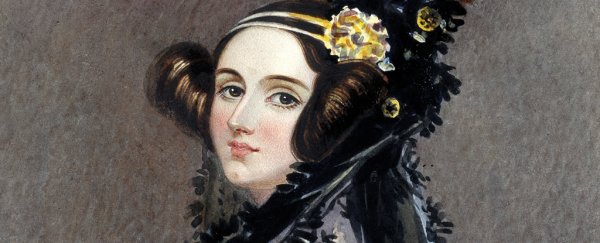Ada Lovelace - more formally known as Augusta Ada King, the Countess of Lovelace - was a 19th century British writer and mathematician popularised as an early developer of programs for emerging computing technology.
Her actual contributions to the foundations of computer programming have been hotly debated, with proponents portraying her as a visionary and critics claiming there is little evidence that she was directly responsible for anything novel.
What does seem to be clear is Lovelace was a remarkable science writer who not only recognised the significance of early computer technology, but had the knowledge and talent for communicating it in ways that still resonate through the ages.
How did Ada Lovelace become a renowned mathematician?
Ada was the only child born into the marriage of the libertine poet George Gordon 'Lord' Byron, and 'Lady' Anne Isabella Noel Byron, 11th Baroness Wentworth and Baroness Byron.
Having rich and famous parents wasn't all it was cracked up to be for the young Ada. Her father sent both her and her mother away when Ada was barely a few weeks old, only to pass away 8 years later having had little to do with the daughter he'd wished was a son.
Ada's maternal grandmother Judith, Lady Milbanke, was responsible for her upbringing on an isolated country estate. Yet her largely absent mother still insisted on a rich education for her daughter, particularly in mathematics. A line of tutors and governesses ensured she had an early education in diverse subjects such as history, languages, and chemistry.
One of those tutors was a Scottish mathematician and astronomer by the name of Mary Somerville, a figure famed as the first person ever to be described - rightly or wrongly - as a scientist.
It was Somerville who introduced a 17-year-old Ada to a highly respected mathematician and mechanical engineer named Charles Babbage, a man who would be forever noted for his invention and engineering of multiple engines capable of carrying out a variety of mathematical functions.
While never completed, one device referred to as an analytical engine is now recognised as the first universal computer. Through a series of appropriately arranged instructions provided on cards with holes punched through them, the massive clockwork engine was intended to process data according to a range of operations, and even hold up to 1,000 large numbers in a memory store.
It was the prototype of a simpler device capable of crunching polynomial functions, called a difference engine, that first attracted Ada's attention soon after meeting Babbage. Through Sommerville, she and the famous engineer would develop a strong intellectual friendship based on mutual love and respect for numbers.
Babbage would inspire Ada in her love of mathematics; Ada would win Babbage's respect for her ability to articulate and promote his work.
When an Italian mathematician named Luigi Menabrea published an article on the analytical engine in 1842, it was Ada who translated it from the French he used into English, appending it extensively with notes that helped the reader understand the basic concepts of how the engines differed.
Did Ada write the first computer program?
One of Ada's notes for Menabrea's article, titled simply as note 'G', describes an algorithm that could be used in conjunction with the analytical engine to compute Bernoulli numbers.
Thanks to her inclusion of this algorithm, Ada Lovelace is regularly reported to be the first computer programmer.
It's undisputed that Ada's notes include the earliest published account of an algorithm designed for what can be regarded as the first (theoretical) universal computer. What isn't clear is just how much credit she deserves for the program's novelty; while she is in no doubt proud of her contributions, there's no evidence that the algorithm in note G was solely, or evenly partially, her own invention.
As stated by historian Bruce Collier in his thesis on the matter;
"Although it is clear that Lady Lovelace was a woman of considerable interest and talent, and it is clear that she understood to a very considerable degree Babbage's ideas about the general character and significance of the Analytical Engine, and expressed them well in her notes to Menabrea's paper, it is equally clear that the ideas were indeed Babbage's and not hers; indeed, she never made any claim to the contrary."
So who deserves to be called the 'first programmer'? As with most things in science and technology, there is no moment of invention that stands out. Babbage certainly knew how his engine should be programmed, but the punch card system it was based on was similar to processes used to style patterns into weaving looms created by a French silk weaver, Joseph Maria Jacquard.
We might imagine the first programs as a mesh of old weaving technology and mathematics tabulated by Babbage, invented not by any single person at all.
Ada's skill for communicating them with such insight and clarity almost certainly helped popularise the idea, and perhaps have driven and even inspired Babbage in his ongoing work, but there is little reason to think of the gifted daughter of Lord Byron as the world's first programmer.
Biography
Born: 10 December 1815 to poet and politician George Gordon Byron, 6th Baron Byron, and Anne Isabella Noel Byron, 11th Baroness Wentworth and Baroness Byron, (also known as Annabella Milbanke).
Died: 27 November 1852, age 36, from cancer of the uterus, possibly escalated by the extreme treatment of bloodletting.
As a person: At age 20, Ada married William King-Noel, 1st Earl of Lovelace and became Lady King, with whom she had three children. Her life was affected by long bouts of illness as a child, and in her later years marred by scandals involving rumours of affairs and a taste for gambling.
All Explainers are determined by fact checkers to be correct and relevant at the time of publishing. Text and images may be altered, removed, or added to as an editorial decision to keep information current.
